Puja and Festivals
Dharma Bee 2020 – Discover Your Hindu Heritage
Week #3, Elementary School
Section 1 – Main Reading
Puja
Referring to previous chapter we know that our Devata (Gods/Goddesses) are there to help us to be a better human being day by day. Let us meet Swara and her grandfather. She has a similar question like us and let us see how her grandfather helps her to understand.
Preface: Swara’s grandparents are visiting her. Swara’s grandfather performs puja every morning. Swara is curious to know why we do puja and how it is done. Grandfather has promised to take Swara to the park. Let’s see what happens next.















WHY PERFORM PUJA?
The reason is in the word itself – “Pu” means ‘to purify’ or ‘to cleanse’ and “ja” means ‘birth’. So, as you perform Puja, you cleanse your body, mind, and intellect and essentially take a new birth each time. So, if you feel that you need to reset your inner self and start anew, Puja is what will help you get there.
While performing a Puja your body, mind, and intellect are all aligned and focused on one thing – your deity. While you are performing the actions with your hands, you are chanting or reciting His name with complete faith and reverence. It’s a great way to discipline yourself and make your mind single pointed.
FESTIVALS
As the new calendar has begun we will be celebrating so many festivals. These festivals are celebrated due to various reasons. Some of them mark the beginning of some seasonal changes, some of them are to celebrate the harvest season, and some of them are to celebrate the birthday of some great people in our society, while some of them celebrate the victory of good over evil.
All of these festivals not only keep us motivated yearlong but also remind us of our glorious past, good values and conduct. Thus, it is very essential that our kids get proper information about them and carry our great tradition and culture forward. We have selected a few festivals here. As beautifully said, “ekam sat vipra bahudha vadanti”; meaning Truth is one, the wise call it differently. Similarly, many festivals celebrated in India are called by different names but the meaning and the reasoning behind the celebration remain the same as we travel from one state to another.
Let us see what Saurish and his mother (Amma) are talking about.






Now, we know all about Makar Sankranti – we celebrate as the days get longer and harvest some fresh crops from the farms. It is celebrated around Jan 14-15th of every year. Let us learn about one more festival.








Section 2 – Additional Reading
Additional Reading #1
Why do we light a lamp?
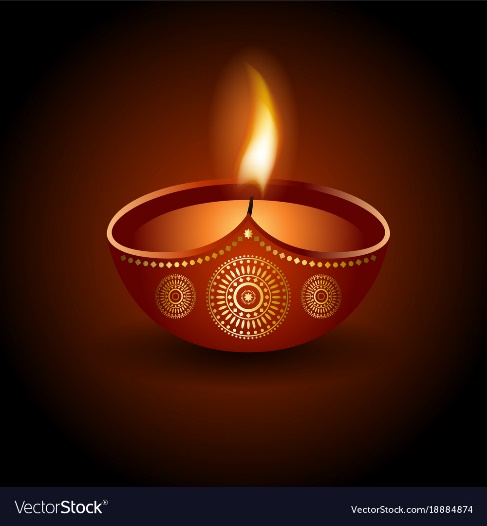 In almost every Hindu home, a lamp is lit daily in the Puja-ghar. In some houses it is lit at dawn and in some, twice a day – at dawn and dusk – and in a few it is maintained continuously (akhanda deepa). All auspicious functions commence with the lighting of the lamp, which is often maintained right through the occasion. Light symbolizes knowledge. The God is the “Knowledge Principle”, illuminator of all knowledge. Hence light is worshiped as the God himself.
In almost every Hindu home, a lamp is lit daily in the Puja-ghar. In some houses it is lit at dawn and in some, twice a day – at dawn and dusk – and in a few it is maintained continuously (akhanda deepa). All auspicious functions commence with the lighting of the lamp, which is often maintained right through the occasion. Light symbolizes knowledge. The God is the “Knowledge Principle”, illuminator of all knowledge. Hence light is worshiped as the God himself.
Knowledge removes ignorance just as light removes darkness. Also knowledge is a lasting inner wealth by which all outer achievement can be accomplished. Hence we light the lamp to bow down to knowledge as the greatest of all forms of wealth
Why not light a bulb or tube? That too would remove darkness. But the traditional oil lamp has a further spiritual significance. The oil in the lamp symbolizes our negative tendencies. When lit by spiritual knowledge, they get slowly exhausted and finally perishes. The flame of a lamp always burns upwards. Similarly, we should acquire such knowledge as to take us towards higher ideals. While lighting the lamp we thus pray:
Deepajyothi parabrahma, Deepa Jyotir Janaardanah
Deepo harati paapaani, Sandhyaa deepa namostute ||
I prostrate to the dawn/dusk lamp; whose light is the Knowledge Principle (the Supreme God), which removes the darkness of ignorance and by which all can be achieved in life.
Why do we have a puja room at home?
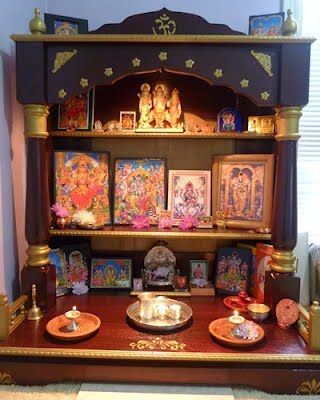 Most Hindu homes have a puja room – prayer room (mandir) or altar. A lamp is lit and the God worshipped each day. Other spiritual practices like japa (repetition of the God’s name), meditation, paaraayana (reading of the scriptures), prayers, devotional singing etc is also done here. Special worship is done on auspicious occasions like birthdays, anniversaries, festivals and the like. Each member of the family – young or old – comes together and worships Bhagawan here.
Most Hindu homes have a puja room – prayer room (mandir) or altar. A lamp is lit and the God worshipped each day. Other spiritual practices like japa (repetition of the God’s name), meditation, paaraayana (reading of the scriptures), prayers, devotional singing etc is also done here. Special worship is done on auspicious occasions like birthdays, anniversaries, festivals and the like. Each member of the family – young or old – comes together and worships Bhagawan here.
The God is the entire creation. He is therefore the true owner of the house we live in as well. The puja room is the Master room of the house. We are the earthly occupants of His property. This notion rids us of false pride and possessiveness.
The ideal attitude to take is to regard the God as the true owner of our homes and ourselves as caretakers of His home. But if that is rather difficult, we could at least think of Him as a very welcome guest. Just as we would house an important guest in the best comfort, so too we felicitate the God’s presence in our homes by having a prayer room or altar, which is, at all times, kept clean and well-decorated.
Also, Bhagwan is all-pervading. To remind us that He resides in our homes with us, we have prayer rooms. Without the grace of the God, no task can be successfully or easily accomplished. We invoke His grace in the puja room each day and on special occasions.
Each room in a house is dedicated to a specific function like the bedroom for resting, the drawing room to receive guests, the kitchen for cooking etc. The furniture, decor and the atmosphere of each room are made conducive to the purpose it serves. So too for the purpose of meditation, worship and prayer, we should have a conducive atmosphere – hence the need for a puja room.
Sacred thoughts and sound vibrations pervade the place and influence the minds of those who spend time there. Spiritual thoughts and vibrations accumulated through regular meditation, worship and chanting done there pervade the puja room. Even when we are tired or agitated, by just sitting in the puja room for a while, we feel calm, rejuvenated and spiritually uplifted.
Why do we offer Prasaad or Neivediyam to Bhagawan before eating it?
Hindus make an offering of food to the Bhagawan and later partake of it as Prasaada – as a sacred gift from Him. Naivedyam is the food offered to Bhagawan as part of our Puja, before eating it. As such, we do not taste the food during preparation or eat the food before offering it to God.
All that is in this Universe is a manifestation of Bhagawan. We are a part of him. All we do is by His strength and knowledge alone. Hence what we receive in life as a result of our actions is really His alone. We acknowledge this through the act of offering all the fruits of our action to the Bhagawan like saying “Sarvam Krishnaarpanam Asthu” or “Sarvam Brahmaarpanam Asthu”.
Similarly we also offer the food to him. Knowing this, our entire attitude to food and the act of eating changes. The food offered will naturally be pure and the best. We share what we get with others before consuming it. We do not demand, complain or criticize the quality of the food we get. We eat it with cheerful acceptance (prasaada buddhi).
The food symbolically stands for our ignorant consciousness, which we place before god for spiritual enlightenment. After he suffuses it with knowledge and light and breathes a new life into our bodies, it makes us divine. When we share the prasaad with others, we share the knowledge we thus gained with fellow beings.
Before eating we recite the following Mantra from Bhagavad Gita (4:24)
Brahmarpanam Brahma havir brahmaagnou brahmanaahutham
Brahmaiva taena gantavyam Brahma karma samaadhina
Meaning: This act of offering is Brahman, The offering or Prasad is also Brahman, It is offered by Brahman into the Agni of Brahman (hunger in our stomach). Brahman is that which is attained by those who performs the action pertaining to Brahman. Basically, all is Brahman. So after offering food thus, it is now eaten as prasaada.
Why do we do Puja?
Puja is an expression of gratitude to our Bhagawan for all that we have. The word Puja in Samskritam means reverence, honor, homage, adoration, and worship. Puja commonly has the following five aspects:
- Anustana – religious practice
- Aaradhana – worship
- Upaasana – an act of sitting or being near to the God
- Sewa – service
- Prarthana – prayer
At the surface, Puja looks like a request to Bhagawan to fulfill a specific desire but it is done primarily for purification of mind (Chitha Shudhi). We all are well aware of external body cleansing like taking a bath, brushing our teeth and so on. But how do we clean the mind? How can we purify our thoughts? Puja helps us do it and to help us do it correctly our Sages/Rishis gave us “Puja Vidhi” – which means the right procedure to perform a
Puja.
To make is easier to understand, let us take the analogy of converting milk to ghee. At first it looks like it is not evident that ghee came from milk. You take a pot of milk, add yogurt culture to it and convert it to yoghurt. If we churn this yoghurt we get butter and if this butter is melted on a slow flame it becomes ghee! So there is a specific process to transform milk to ghee.
A mind filled with angry thoughts is called the angry mind. A mind with pure and positive thoughts is called a pure mind. Hence it is the thoughts that fill the mind makes it either good, bad, pure or impure. As the thoughts, so the mind. As the mind, so the man. So, the mind can be cleansed regularly through Puja.
Now, let’s know about the Puja vidhi. Puja should be done with Trikarana Shudhi – combination of the below three aspects. If any one of these aspects are missing it will not qualify to be called as Puja.
- Manasa -Thoughts – Visualize the upacharam performed in mind.
- Vaacha – Words – Use of the appropriate mantra for each upacharam
- Karmana – Deeds – Procedure prescribed in kalpam as mentioned by rishi.
Shri Chandrasekharendra Saraswati (Paramacharya), sage of Kanchi Kamakoti Peetham explained very well about Trikarana Shudhi. Paramacharya was once talking to the students about their exam results and marks they got in each of the subjects. Paramacharya asked a follow-up question “If you get 90% in Physics, 60% in Chemistry and only 20% in Math, can you be considered to have passed the exam?” Immediately the students answered “No”.
Swami Ji asked “Why not?” Students responded “Swami ji you need to pass all the subjects to clear the exam”.
Paramacharya smiled and said “Is that so? Suppose you are very good in actions and get
90%, you are good in your speech and get 60% but, you are weak in thoughts and get only
20%. Can you consider to have passed the Bhagawan’s exam?” Thus he explained with a very simple example the need to do well in Thoughts, Words and Deeds. This is Trikarana Shudhi.
There are two types of Puja Vidhi – External & Internal.
- External – Using a Murti or Prathima and Puja items
- Internal – Maanasa Puja, performing puja in one’s mind.
External Puja can be a very simple Puja with just 5 steps or very elaborate with 64 steps and more. On auspicious days we perform elaborate Puja during Utsavs (festivals) like Vinayaka Chathurthi, Sri Rama Navami, Ugadi etc.
Additional Reading #2
More Festivals
Raksha Bandhan
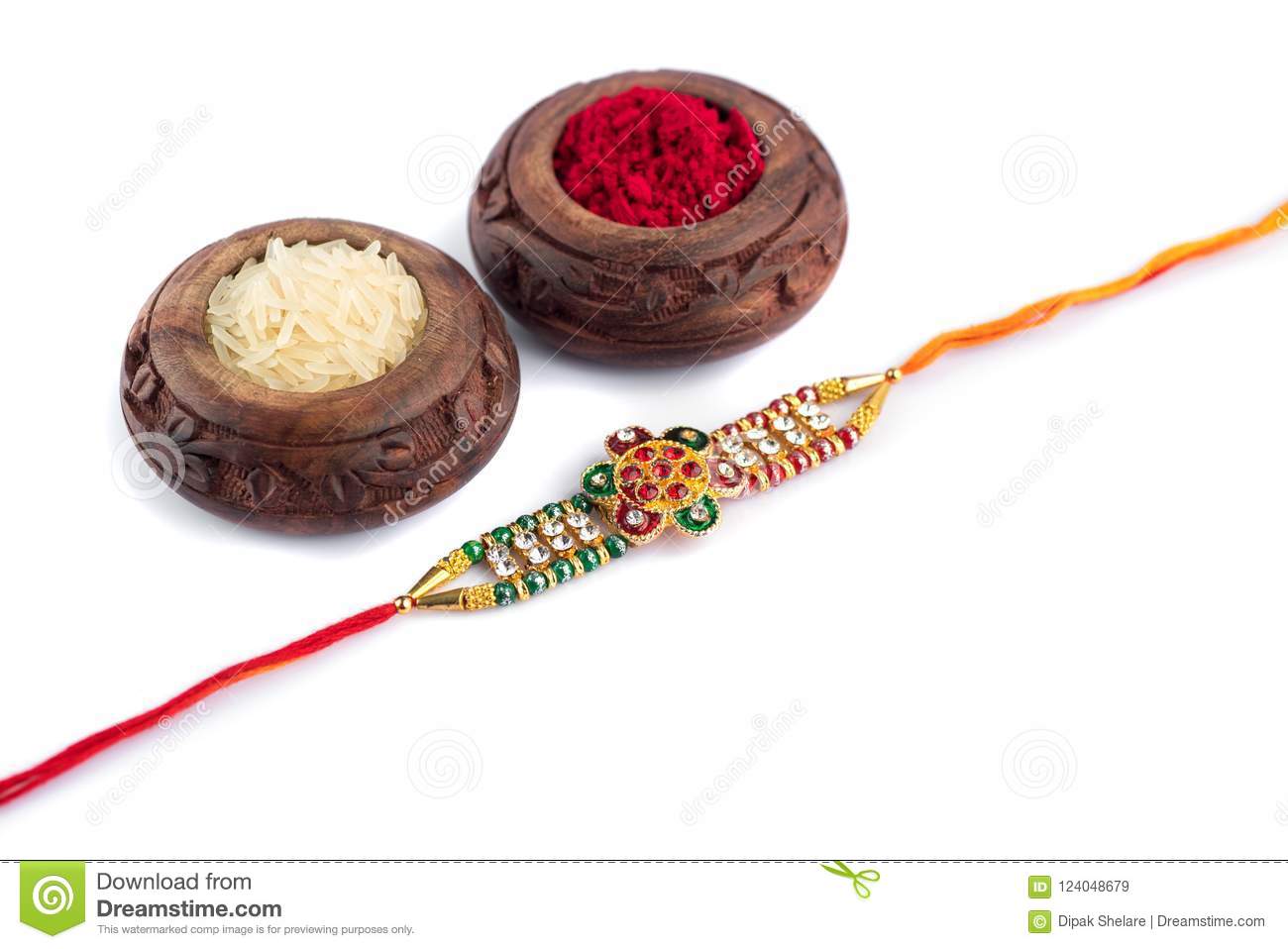 The Raksha Bandhan is a celebration of the abiding and chaste bond of love between the brother and the sister. It is also known as Rakhi Poornima as it is celebrated on the full moon (Poornima) day of the holy month Shravana (August). The Raksha Bandhan festival stirs up one of the deepest and noblest emotions in the human heart – the abiding and chaste bond of love between the brother and the sister. The duties of brothers and the love and affection of sisters are symbolized through the tying of Rakhi. In earlier days, it was merely a festival of brothers and sisters, but now it has become of all.
The Raksha Bandhan is a celebration of the abiding and chaste bond of love between the brother and the sister. It is also known as Rakhi Poornima as it is celebrated on the full moon (Poornima) day of the holy month Shravana (August). The Raksha Bandhan festival stirs up one of the deepest and noblest emotions in the human heart – the abiding and chaste bond of love between the brother and the sister. The duties of brothers and the love and affection of sisters are symbolized through the tying of Rakhi. In earlier days, it was merely a festival of brothers and sisters, but now it has become of all.
On the Raksha Bandhan day, the festivities start by the day break. Everyone gets ready early and gathers for the worship of the deities. After invoking the blessings of the Gods, the sister puts tika and chawal (rice) on his forehead, ties Rakhi and performs brother’s aarati. Then she gives him sweets and gifts. The brother accepts her offerings and vows to take care of her and be by her side in the time of need. As a token he gives the sister a return gift and sweets. Emotions can be expressed through emails, greeting cards, and rakhis through internet or mail in case siblings cannot meet in person.
On this day, in the coastal regions of Bharat, Bharatiya people worship the rain God Indra and the Sea God Varuna. They offer coconut and seek their blessings. Fishermen start their voyages on this day for fishing. The farmers start sowing seeds on this day and pray for a good crop. It is said that Sri Rama started for Lanka to rescue Sita on this day. He crossed the sea from the bridge made by the Vanar Sena by throwing stones in water.
Thousands of events highlight the importance of the Raksha Bandhan. For instance, in Mahabharata, when Sri Krishna kills Shishupaala with his weapon, Sudarshan-Chakra, his finger gets wounded. Seeing this Draupadi tears a piece of cloth from her sari and ties on the wound. And after quite some time, when Draupadi was insulted by the Kauravas, Sri Krishna rescues her by showering saaris. In another incident, once Yudhishthira asked Sri Krishna how best he could guard himself against impending evils and catastrophes in the coming year. Sri Krishna advised him to observe the Raksha ceremony.
The sister-brother relationship highlighted by the Raakhi goes far beyond the mere personal protection of a female from a male. It also implies the basic element of an amicable and harmonious social life where all members of the society look upon themselves as brothers and sisters and as children of mother Earth. In Hindu tradition, Raksha has assumed all aspects of protection of the forces of righteousness from the forces of evil.
Raksha Bandhan festival helps to develop the sentiment of the universal brotherhood which is the need of today’s world to keep the social harmony and piece. The sentiment of universal brotherhood will eventually lead us to the sense of universal oneness. A society imbued with this spirit can live and prosper amidst all kinds of challenges either from within or without. Powers of intellect, body, and of material wealth and influence will then be utilized for the upliftment and service of others. The idea of the Hindu has always been:
Sarvepi sukhinah ssantu, sarve santu niraamayaah |
Sarve bhadraani pashyantu, maa kashchit duhkhabhaag bhavet ||
(Let everyone be happy, let everyone be free from all ills, let everyone behold only the auspicious, let no one be afflicted.) Raksha Bandhan is the most useful mean to bring this idea into reality – making a commitment to protect each other and also the society as a whole is emphasized through this simple ceremony.
Raksha Bandhan is the most auspicious occasion to recharge ourselves every year with the true spirit of service and sacrifice for the welfare of the society, and find therein the highest spiritual fulfillment of human life.
Deepavali
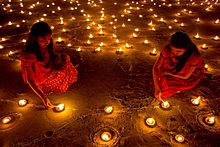 Deepavali is the festival of lights. Deepa means light and Avali means a row. It means a row of lights. Deepavali, in short, is a celebration for adoration of light. Deepavali has a special place among all the festivals of Hindus. Its greatest characteristic is that it is not related to any specific caste, class or province. Even non-Hindus celebrate this Hindu festival. It is truly a universal festival. The festival is celebrated by all people with great enthusiasm to dispel darkness and light up their lives.
Deepavali is the festival of lights. Deepa means light and Avali means a row. It means a row of lights. Deepavali, in short, is a celebration for adoration of light. Deepavali has a special place among all the festivals of Hindus. Its greatest characteristic is that it is not related to any specific caste, class or province. Even non-Hindus celebrate this Hindu festival. It is truly a universal festival. The festival is celebrated by all people with great enthusiasm to dispel darkness and light up their lives.
The festival symbolizes unity in diversity as every province celebrates it in its own special way. People wear new and bright clothes. The radiant sight of everybody adorned with new and bright clothes, especially women adorned with the best of ornaments, captures the social mood at its happiest. People clean and paint their houses and adorn them by lighting up “Diyas” (earthen lamps) and making “Rangoli” in front of their houses. Even the humblest of huts are lighted by a row of “Diyas”. People
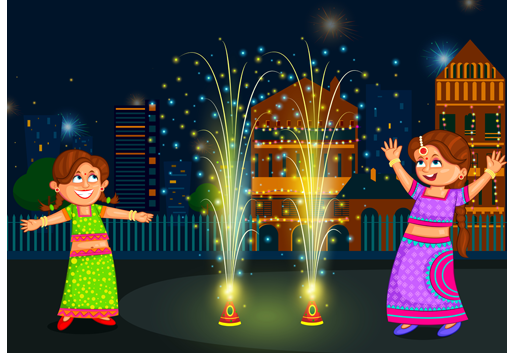 invite their friends and neighbors and offer them sweets and snacks specially prepared for the festival. They send greeting-cards to loved ones.
invite their friends and neighbors and offer them sweets and snacks specially prepared for the festival. They send greeting-cards to loved ones.
Crackers (fireworks) resound and light up the earth and the sky. Illumination – Deepotsavas – and fireworks, joy and festivity, is to signify the victory of divine forces over wickedness. Illumination in temples and all sacred places of worship symbolize the scattering of spiritual radiance all round from these holy centers. All these illumination and fireworks, joy and festivity, is to signify the victory of divine forces over those of wickedness.
Deepavali is generally a five days festival. Those five days are – Dhana- trayodashi or Dhanteras, Narak-chaturdashi, Lakshmi-Pujan, Bali-Pratipada and Bhai-Duj. Each day has its own importance. Though there are numerous legend associated with all 5 days, we shall see the most recognized ones.
 The first day of Deepavali is Dhanteras and dedicated to Goddess Lakshmi, whose blessings are essential for a prosperous, fruitful and peaceful life. The word “Dhan” means wealth. It is also believed that the main divinity of Ayur-Veda (knowledge of life – Indian medicine) called Dhanvantari (image on the left) first manifested on this day. Hence the importance attached to this day for the healing profession – practitioners of Ayur-Veda.
The first day of Deepavali is Dhanteras and dedicated to Goddess Lakshmi, whose blessings are essential for a prosperous, fruitful and peaceful life. The word “Dhan” means wealth. It is also believed that the main divinity of Ayur-Veda (knowledge of life – Indian medicine) called Dhanvantari (image on the left) first manifested on this day. Hence the importance attached to this day for the healing profession – practitioners of Ayur-Veda.
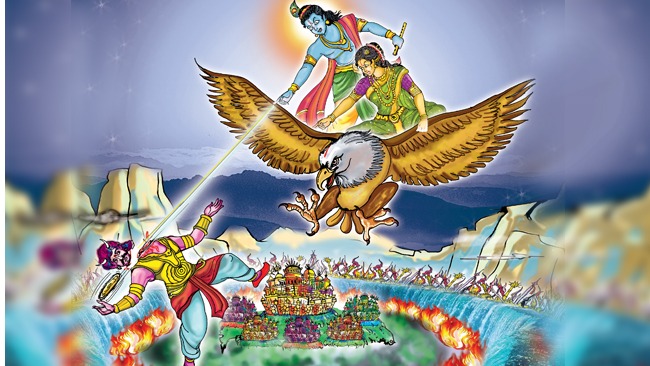 Slaying of the demon Narakasura by Sri Krishna is the most recognized legend for the second day of Deepavali. With the help of Narakasura’s own mother – Bhudevi (Mother Earth), Sri Krishna killed him on this second day of Deepavali. Bhudevi herself requested Sri Krishna that this day be celebrated as one of jubilations. Sri Krishna granted her request and since then the tradition has continued. Bhudevi reconciled herself to the loss of her son as she knew that her son was killed for the welfare of world. Thus she set a glowing example of how one has to brush aside one’s personal joys and sorrows in the interest of society.
Slaying of the demon Narakasura by Sri Krishna is the most recognized legend for the second day of Deepavali. With the help of Narakasura’s own mother – Bhudevi (Mother Earth), Sri Krishna killed him on this second day of Deepavali. Bhudevi herself requested Sri Krishna that this day be celebrated as one of jubilations. Sri Krishna granted her request and since then the tradition has continued. Bhudevi reconciled herself to the loss of her son as she knew that her son was killed for the welfare of world. Thus she set a glowing example of how one has to brush aside one’s personal joys and sorrows in the interest of society.
After the slaying of Narakaasura, Sri Krishna bathed himself smearing his body with oil in the early morning of Chaturdashi. That is why it is a custom to be followed on Deepavali to get up early in the morning, massage the body with a mixture of oil, flour and haldi (turmeric) before the daily bath. This practice is also healthy for our skin.
Third day of Deepavali is the new moon day, auspicious for offering prayers and gratitude to the bygone ancestors of the family and invoking their memories and blessings for treading the path of right conduct. This is also the sacred occasion for the worship of Lakshmi, 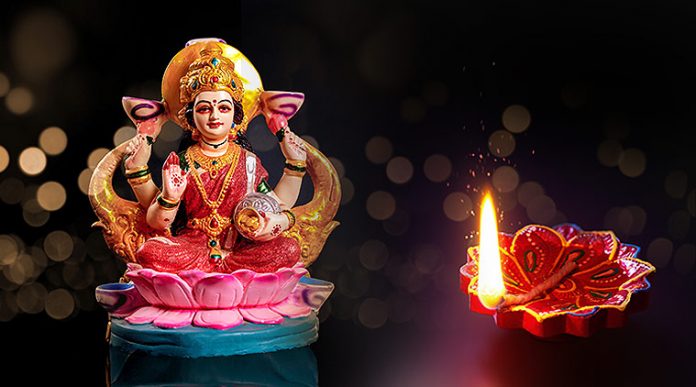 the goddess of Wealth and Prosperity. The business community opens its New Year’s account with Her worship. It is believed that Goddess Lakshmi visits everybody’s home. People keep their homes clean and light lamps to welcome Her. Lakshmi-Puja is performed on this very day. It is believed that on this auspicious day Sri Krishna discarded his body.
the goddess of Wealth and Prosperity. The business community opens its New Year’s account with Her worship. It is believed that Goddess Lakshmi visits everybody’s home. People keep their homes clean and light lamps to welcome Her. Lakshmi-Puja is performed on this very day. It is believed that on this auspicious day Sri Krishna discarded his body.
 The next day of Deepavali is Bali-pratipada. Bali Pratipada or Padwa is a symbol of love and devotion between the wife and husband. On this day newly married daughters with their husbands are invited for special meals and given presents. This auspicious day is also considered as a beginning of New Year according to one Hindu calendar (Vikrama shaka). Therefore, on this day, new ventures are begun, house-warming Pujas are performed, and people also may choose to buy gold, silver or property on this day.
The next day of Deepavali is Bali-pratipada. Bali Pratipada or Padwa is a symbol of love and devotion between the wife and husband. On this day newly married daughters with their husbands are invited for special meals and given presents. This auspicious day is also considered as a beginning of New Year according to one Hindu calendar (Vikrama shaka). Therefore, on this day, new ventures are begun, house-warming Pujas are performed, and people also may choose to buy gold, silver or property on this day.
There are some legends associated with this day. It is said that Sri Brahma created the Universe on this day. On this very day, Sri Vishnu, incarnated in the form of a dwarf Brahmin by name Vamana and punished the demon king Bali. It is also believed that on this day, Sri Rama returned to Ayodhya with Sita victorious after killing the demon king Ravana. This is also the day for Govardhana Puja and Anna Koota (heap of grains), the former signifying the Govardhana episode in Sri Krishna’s life and the latter conveying affluence and prosperity.
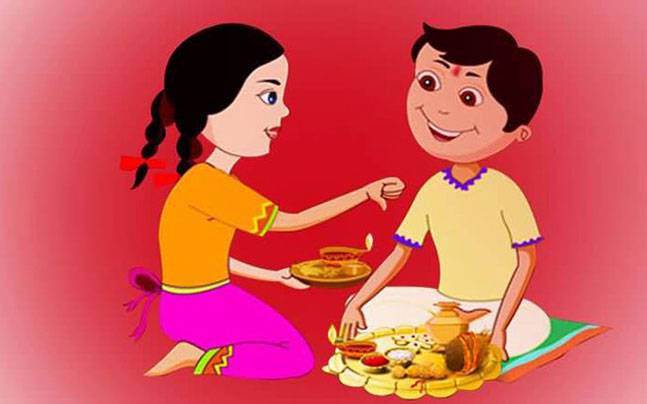 The last day of Deepavali is Bhai-duj. It is primarily a day of brother and sister. It is a most touching moment for the family members when even distant brothers reach their sisters to strengthen that holy tie. The sister applies tilak and waves aarati to her brother, wishes him a long & healthy life and offers him sweets with warmth and the brother offers loving presents to the sister. Those who do not have a brother perform a sort of puja to the Moon-God.
The last day of Deepavali is Bhai-duj. It is primarily a day of brother and sister. It is a most touching moment for the family members when even distant brothers reach their sisters to strengthen that holy tie. The sister applies tilak and waves aarati to her brother, wishes him a long & healthy life and offers him sweets with warmth and the brother offers loving presents to the sister. Those who do not have a brother perform a sort of puja to the Moon-God.
There is one more episode associated with Deepavali which is the great event of Mahavir attaining the Eternal Bliss of Nirvaana. The passing into Eternity on the same day of Swami Dayananda Saraswati, that leonine sanyasin who was one of the first to light the torch of Hindu Renaissance during the last century, and of Swami Ramatirtha who carried the fragrance of the spiritual message of Hindu Dharma to the western world, have brought the spiritual tradition of Deepavali right up to modern times.
Ganesh Chaturthi
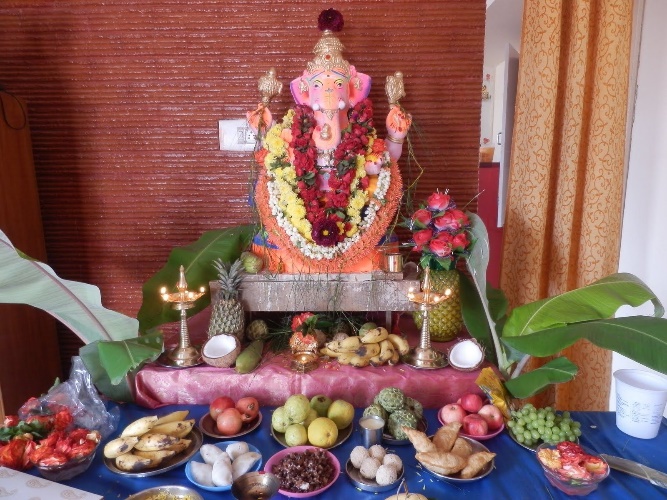
Bhagawan Ganesha bestows wisdom and wealth, removes obstacles, and grants success in any noble endeavor. He is one of the five devatas of daily worship in the system of panchaayatana Puja (the five are: Surya, Ganapathi, Ambika, Shiva, and Vishnu). He is known by many names, such as Vinayaka, Ganapathi, Lambodara, Herambha, etc. Ganesha Chaturthi is His birthday. It is celebrated on the fourth tithi during the bright half (shukla paksha) of the bhaadrapada maasa (month), around September. Celebrations with daily homas, Pujas, and prayers continue for ten days till the anantha chaturdashi day. The earliest celebrations of this festival go back to the times of Shatavahana (230BC-22CE), Chalukya (540-750 CE), and Rashtrakuta (6-7th century) rules in Bharat. Since Shivaji’s time and through the period of Bharat’s freedom struggle, this festival became a great unifier of the Hindu society. As the resistance to the British rule in Bharat increased during the 1890’s, the British banned public assemblies. This led to Lokamaanya Blagangadhara Tilak popularizing the public celebration of Ganesha Chaturthi and using it as a means to spread the message of the freedom struggle.
These days Ganesha Chaturthi is one of the most colorful public festivals celebrated by Hindus throughout Bharat as well as in many countries outside Bharat. For a typical festival, a life-like clay model of Lord Ganesha is made 2-3 months prior to the day of the festivities. The size of this murti may vary from 3/4th of an inch to over 25 feet. On the day of the festival, it is placed on a raised platform (in home or an outdoor tent). Divinity is then invoked into the murti amidst the chanting of mantras. This is ‘pranapratishtaa’. After this the ‘shodashopachara’ (16 ways of paying tribute) follows. Coconut, jaggery, 21 ‘modakas’ (rice flour preparation), 21 ‘durva’ (trefoil) blades (a type of grass) and red flowers are offered. Throughout the ceremony, Vedic hymns from the Rig Veda and Ganapathi Atharva Shirsha Upanishad, and Ganesha sthotra from the Narada Purana are chanted. For ten days, from bhadrapada Shukla Chaturthi to the ananta Chaturdashi, Ganesha is thus worshipped. As in any Hindu festival, food offered (naivedyam) is saatvic; onion and garlic are strictly avoided!
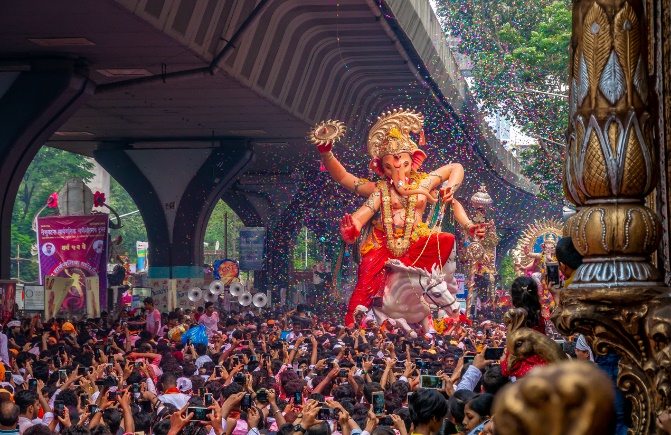 The public venue serves as the focal point for free medical checkups, blood donation camps, charity for the poor, drama performances, films, devotional songs, etc. during the ten days. On the 11th day, Ganesha ji is taken through the streets in a procession accompanied with drumbeats, dancing, singing, and then immersed in a river or sea symbolizing a ritual see-off of the Lord to his abode in Kailasa. Throughout Bharat, thousands of such processions carrying the Ganesha murtis on decorated floats are taken and the murtis are immersed with great splendor.
The public venue serves as the focal point for free medical checkups, blood donation camps, charity for the poor, drama performances, films, devotional songs, etc. during the ten days. On the 11th day, Ganesha ji is taken through the streets in a procession accompanied with drumbeats, dancing, singing, and then immersed in a river or sea symbolizing a ritual see-off of the Lord to his abode in Kailasa. Throughout Bharat, thousands of such processions carrying the Ganesha murtis on decorated floats are taken and the murtis are immersed with great splendor.
Navaratri and Vijayadashmi
Navaratri is a festival of Goddess Durga. Goddess Durga is also known as Universal Mother. Goddess Durga is believed to exist in many forms such as Goddess Bhavani, Jagdamba, Mahakali, Chamundeshwari and Amba. The word “navaratri” literally means nine nights. This festival is celebrated for nine days. The nine days are divided and devoted to Saraswati (Goddess of Learning), Lakshmi (Goddess of Wealth and Prosperity), and Durga (Goddess of Strength and Courage).
 Goddess Durga is considered as a Goddess of strength and courage. In other words, SHE is energy (and power) aspect of the Almighty. That is why SHE is also known as “Shakti (power)”. Thus on this day, we invoke the energy aspect of God in the form of Durga. Literally, Durga means the remover of difficulties.
Goddess Durga is considered as a Goddess of strength and courage. In other words, SHE is energy (and power) aspect of the Almighty. That is why SHE is also known as “Shakti (power)”. Thus on this day, we invoke the energy aspect of God in the form of Durga. Literally, Durga means the remover of difficulties.
Why Goddess Durga is worshipped on this day? And why for nine days? Well! There is striking story behind this. The story goes like this: Mahishasura performed severe penance and became the ruler of the three worlds; heaven, earth and the nether-world. Unable to stand his atrocities, Gods requested Sri Vishnu to help. Sri Vishnu advised them that Mahishasura could be killed only when the combined strength of all gods strikes him. So, Gods, including Sri Vishnu, combined their powers in a physical form of Goddess Durga. Goddess Durga, then, fought with the demon Mahishasura. The battle lasted long for nine days. At last, on the tenth day, SHE killed the demon Mahishasura and freed the three worlds from his shackles. That is why SHE is also called by “Mahishasura Mardini”, destroyer of Mahishasura.
Vijayadashami is a festival of victory. In Samskrit, ‘vijaya’ means victory and ‘dashami’ means 10th day. Thus ‘Vijaya Dashami’ means victory on the 10th day. It is one of the most auspicious days in the Hindu calendar. These nine days of Navaratri and the tenth day of Vijaydashmi fall in month of October.
Vijayadashami is a festival of victory because it is resplendent with many an inspiring episode reflecting the victorious culmination of deeds of valor of our ancestors. Not just the death of Mahishasura, but this day is marked by significant victories in Ramayana and Mahabharata as well. On this day, Shri Rama killed Ravana and achieved a triumphant victory over the asuras. Shri Rama worshipped Goddess Durga just before the battle with the demon Ravana started. Shri Rama worshipped Shami tree on this day just before proceeding to Ayodhya. In Mahabharata, Pandavas spent thirteen years in exile. During the last year of ajnaat-vaas (living incognito), they had hidden their arms in the Shami tree. This is the day, their ajnnat-vaas was over and they had taken out their arms from the Shami tree and revealed their identity. That marked their preparation for the victorious war of Kurukshetra. Invoking these inspiring memories, the Shami tree is worshipped on this day.
How is it celebrated?
Navaratri is divided into sets of three days to adore different aspects of the supreme Goddess. On first three days, the Supreme Goddess is invoked as powerful force called Durga in order to destroy all our impurities, vices and defects.
The next three days, the supreme Goddess is adored as a giver of material and spiritual wealth, Lakshmi. The last three days are spent in worshipping the supreme as the goddess of wisdom, Saraswati. In order to have all-round success in life, we need the blessings of all three aspects of the divine supreme.
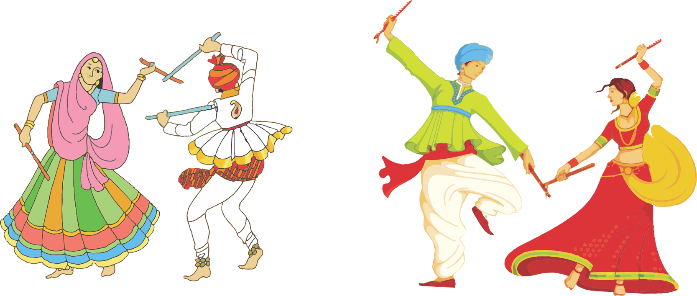 The most common form of public celebration is the performance of garba and/or dandia-raas. Garba is a graceful form of dance, wherein women, dressed in traditional clothes, dance gracefully in circles around a pot containing a lamp or image of the goddess. Besides, the Garba is the “Dandia” dance, in which men and women participate in pairs with small, decorated bamboo sticks called dandias in their hands. The dances usually commence late in the night and continue until early morning. Another prevalent practice is of sowing pulses, cereals and other seeds on the first day of this festival in a pot, which is watered for nine days at the end of which the seeds sprout. This pot is worshipped throughout the nine days.
The most common form of public celebration is the performance of garba and/or dandia-raas. Garba is a graceful form of dance, wherein women, dressed in traditional clothes, dance gracefully in circles around a pot containing a lamp or image of the goddess. Besides, the Garba is the “Dandia” dance, in which men and women participate in pairs with small, decorated bamboo sticks called dandias in their hands. The dances usually commence late in the night and continue until early morning. Another prevalent practice is of sowing pulses, cereals and other seeds on the first day of this festival in a pot, which is watered for nine days at the end of which the seeds sprout. This pot is worshipped throughout the nine days.
There are some other modes of public celebration too. Just like Ganesha festival, people build temporary but huge and beautifully decorated puja mandaps and place images of the Goddess Durga and all together worship for nine days. On the 10th day (Vijayadashami) grand processions with Durga’s image are taken out along the streets and immersed in water. Majestic processions of elephants and horses to the temple are also very common. Although there have been different forms of celebrations, the purpose of celebration is one and the same – worship Goddess Durga and get the blessings of all three aspects of the divine supreme. It signifies the victory of the forces of righteousness over those of wickedness. It marks a new and prosperous beginning.
New ventures, started on this day, are believed to flourish and bring prosperity. This day, as culmination of Saraswati Puja, is also called ‘vidyaadashami’ and is considered as a good day for the beginning of the new studies (vidyaarambham). Therefore, children start tutoring on this day – to have a head start in their education. In the medieval period, the Hindu Kings used to start their mission on this day and that is called ‘seemollanghan’, i.e., going beyond once own boundaries.
In old days, each individual used to carry a weapon. They used to worship their weapons on this day. It is called “Aayudha (weapons) Puja”. The same tradition is continued with some modifications. Now-a-days Hindus worship different types of things which are modes of their earning and progress. For example, student worship books, businessmen worship their factories and machines, musicians worship their instruments and technical workers worship their tools. Even vehicles are also washed, decorated and worshipped (picture below). To celebrate Shri Rama’s victory, Rama-leela is observed by the people with great enthusiasm. Ram-Leela is a stage enaction of Ramayana. On this day, people arrange a street play based on the Rama-Ravana war. They create dummies of 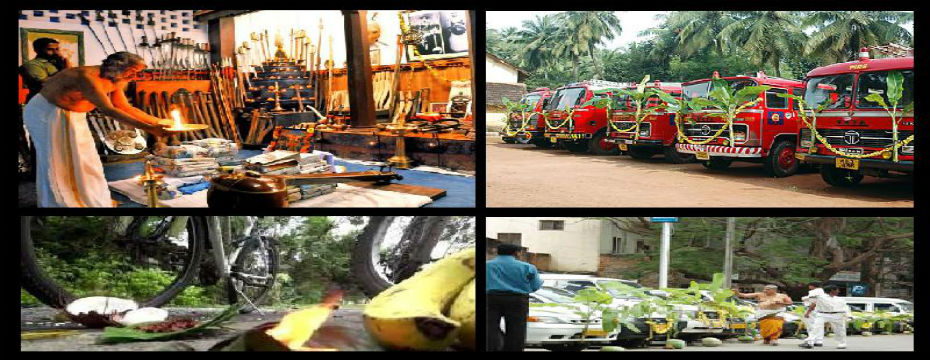 Rama, Sita, Lakshamana and Ravana. Rama-Lakshamana aim at Ravana’s dummy with burning arrows and burn dummy Ravana. After that, people welcome Rama, Sita and Lakshamana as if they are welcoming real ones. The lesson of this legend is so beautifully clear. Even the good and the righteous can succeed against the evil forces only when they come together in an organized endeavor. Could there be a more telling message to the present-day?
Rama, Sita, Lakshamana and Ravana. Rama-Lakshamana aim at Ravana’s dummy with burning arrows and burn dummy Ravana. After that, people welcome Rama, Sita and Lakshamana as if they are welcoming real ones. The lesson of this legend is so beautifully clear. Even the good and the righteous can succeed against the evil forces only when they come together in an organized endeavor. Could there be a more telling message to the present-day?
What message does it deliver?
The story of Mahishasura Mardini says that Gods could kill Mahishasura only when their powers were combined together in an organized fashion. Even good and righteousness cannot win over the evil, if not organized. Even in today’s world, being good and superior on an individual level is not sufficient. All good people should be united and organized. Only in that case they can win over the evil forces. Truly it has been said that – “Sanghe Shaktih Kalau yuge” – means organization (unity or coming together) holds the key to strength in Kaliyug (today’s time).
A second message is that wealth creation and accumulation on the material and spiritual arenas is important individually as well as collectively. Lastly, acquiring the infinite wisdom of our Vedic ancestors so that we personally and socially attain everlasting happiness is the message of this festival.
Section 3 – Take Away and Questions
Take Away for this week:
- As you perform Puja, you cleanse your body, mind, and intellect and essentially start anew.
- Puja helps to make sure your body, mind, and intellect are all aligned and focused on one thing – your deity – makes you more disciplined.
- Festivals are celebrated for various reasons but along with fun and food each one holds an important message and significance.
- Sankranti – celebration of longer days
- Hindu New Year – beginning of spring and new year
- Raksha Bandhan – celebrate oneness in everyone and vow to take care of each other
- Ganesh Chaturthi – celebrate Bhagawan Ganesha
- Navaratri and Vijaydashmi – victory of good over evil
- Deepavali – Festival of Lights
Explore:
- MY ROUTINE: Can you come up with your own Puja sequence to follow every morning? Here is one suggestion:
- Shower and wear clean clothes
- Apply tilak/kumkum
- Light a diya and/or aggarbatti
- Say some shlokas you know in front on Bhagwan
- Offer some fruit/nuts/milk or cooked food as naivedyam
- Do aarti
- Do Pranaam
- THINK: What is your favorite festival and why?
- FAMILY CONNECTION: Depending upon which part of India your family is from, there might be some specific festivals they celebrate (not covered here) or some specific ways of celebrating. Next time you talk to your grandparents (or you can ask your parents), find out what are they?
Questions:
Match the description and festival.
| Deepavali | Festival of Victory of Good over Evil | |
| Raksha Bandhan | Festival of Lights | |
| Vijaya Dashami | Festival of Oneness | |
| Sankranti | Festival of Ganesha | |
| Ganesh Chaturthi | Festival of Harvest |
Bonus Questions:
1. Why do you do Puja?
2. Light removes _________. Light represents ___________.
3. True or False. You can eat before offering the naivedyam to Bhagwan.
4. Deepavali is celebrated for how many days?
For Group 3-5
Write the correct letter in the blank.
1. Goddess Lakshmi is considered as goddess of ____________.
a. wealth b. knowledge c. strength d. none of these
2. Bhai-dhuj (5th day of Deepavali) primarily belongs to ____________________.
a. mother and son b. brother and sister c. none of these
3. ______________ is the beginning of new year for some during the 5 days of Deepavali.
a. Bhai-duj b. Bali Pratipada c. Dhanteras d. none of these
4. ______________ attained Nirvana during the festive days of Deepavali.
a. Buddha b. Guru Nanak c. Mahavir d. none of these
5. _________________ is the symbol of love and devotion between husband and wife.
a. Bhai-duj b. Bali Pratipada c. Lakshmi Puja d. none of these
6. Sri Krishna and Bhudevi punished ___________________
a. Ravana b. Kamsa c. Indrajit d. Narakasura
7. All the following are associated with Vijayadashami EXCEPT _________________.
a. Sri Rama killed Ravana b. Durga killed Mahishasura
c. Krishna killed Narakasura d. Pandacas prepared for war in Kurukshetra
8. All the following are associated with Navaratri and Vijayadashmi EXCEPT _________.
a. Garba b. Ayudha Puja c. universal oneness d. Ramleela
9. Rama returned to Ayodhya during ______________
a. Sankranti b. Ganesh Chaturthi c. Vijayadashmi d. none of these
10. Diya or light represents ___________ (write all that apply)
a. Knowledge b. God c. darkness d. Ganesha
True or False.
1. Puja helps cleanse our body and mind but not our intellect.
2. Sitting near Bhagwan and doing Puja helps us remove anger and focus on good morals and conduct.
3. Festivals are celebrated due to various reasons such as seasonal changes, celebrate great personalities or Gods and Goddesses, and celebrate victory of evil over good.
4. Thoughts, words and deeds matter during puja.
5. Days become longer and longer as Earth’s northern hemisphere points towards the sun which happens during Sankranti.
6. Sri Rama won over Ravana on the day of Deepavali and came back to Ayodhya on Vijayadashmi.
Put the following festivals in correct order starting in January.
| Deepavali | 1. | |
| Raksha Bandhan | 2. | |
| Vijaya Dashami | 3. | |
| Sankranti | 4. | |
| Ganesh Chaturthi | 5. | |
| Hindu New Year | 6. |
In your own words, describe the message of:
1. Raksha Bandhan
2. Hindu New Year
3. Vijayadashmi
4. Deepavali
5. Any other festival not listed in the material but you know about?
6. Lighting a diya
7. Offering Naivedyam
8. Doing Puja







